#more of the worldbuilding
Text
Something that completely flew over my head (I am not very observant), I was rereading chapter 87: Winged Lion II to re-check some things about dungeons and I just now realized the ancient humans weren't from the current races we know.

They seem to have characteristics from several of the human races together, and some of them even seem to have fur (like demi-humans?)
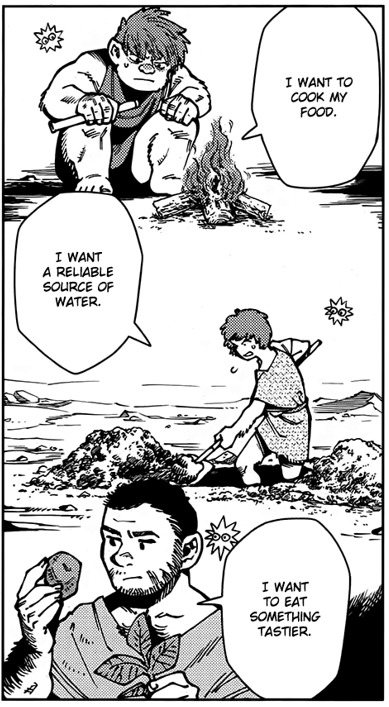
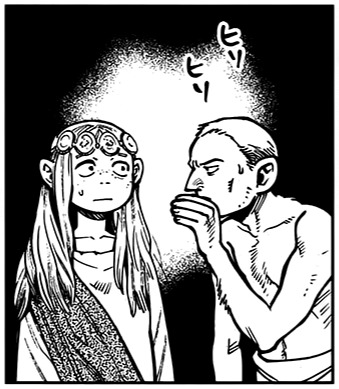
It's even implied that the lifespan differences and physical differences (the two asking for muscles and using magic in the background) were due to the Demon granting wishes

I did notice this part but I didn't realize this was probably part of the source of the race differences rather than the races already being different and wishing for different things.
So at some point the human races might have been even more closely related, before a powerful being influenced their evolution.

#dungeon meshi#dungeon meshi spoilers#dunmeshi thoughts#major spoilers#Dungeon Meshi races#worldbuilding#Winged Lion#Demon#fantasy worldbuilding#I probably only noticed this now cause I became more used to the races while writting this blog#so the shorter pointy ear the fur and the tall gnome looking humans called my attention#I unfortunately dont pay much attention to how characters look usually
6K notes
·
View notes
Text
"why don't super-intelligent Pokemon like Metagross and Alakazam just take over humanity if they're smarter than us" imagine that a random primate gave you free housing, food, and medical care for the rest of your life for literally no reason other than they want to be friends with you and I think you'll understand
#pokemon#pkmn#pokemon worldbuilding#outdesign posts things#maybe they just wanna be friends with us. ever consider that#the only time they would have a reason to beef with humanity would be like PLA times#and even that seems to be more of a 'stay off our territory and we'll stay off yours' kind of thing
5K notes
·
View notes
Text

Quick worldbuilding comic about magical items.
#gonna do more of these#i'm trying to let myself be looser/less perfectionist#my art#comic#doodle#twilight sparkle#celestia#mlp#the grand galloping 20s#yes this was inspired by kui's worldbuilding comic doodles for dungeon meshi
4K notes
·
View notes
Text

Worm on a string AU, ghosts are stringless worms.
---
When a worm meets the unfortunate fate of a snapped or cut string, it is typically the end for them.
However, for reasons yet to be widely known, a worm may persist as a Worm off the String.
P2, P3
Masterpost
#danny phantom#I kinda wanna do more with this and make it a real AU#Give it some actual worldbuilding#DannyPhantomWormAU#beastyart#comic#art
3K notes
·
View notes
Text


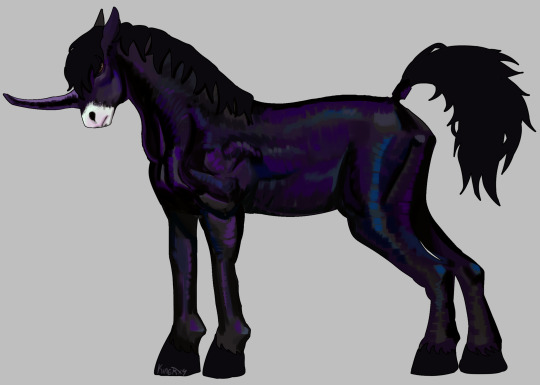
Honrses
#theyre supposed to be used as war montures and also for transportation like irl horses but they are not shy or afraid#so like theyre really hard to tame idk theyre just concepts still#honestly looking at them now they seem too horse like i'll probably redesign them to look more bulky like a rhino#so my idea is that unicorns exist in my setting but they went extinct and these are part of the same genus but lack magic qualities#and instead theyre more about raw force and impaling stuff#i will add them to my bestiary so i'll explain better when its time#wgd#worldbuilding#horse art#art#my art#digital art#dark fantasy
2K notes
·
View notes
Text

1K notes
·
View notes
Text






The many shapes that a Mimer can take. Their origins are unknown, their biology seems to be horrendous and beyond human comprehension, and it is truly considered to be a puzzling enigma. How does something change its overall body composition within hours?
A shapeshifting dragon-like creature capable of taking multiple forms for intimidation purposes. It can also appear to mimic humans, speech and looks wise. although, it seems quite skittish and shy when approached.
#digital art#art#sketch#artists on tumblr#oc art#oc#creature design#monster#monster folk#dragon folk#dragon#unnamed worldbuilding project#may delete later perhaps idk#more of the guy for those who like him a lot
837 notes
·
View notes
Text



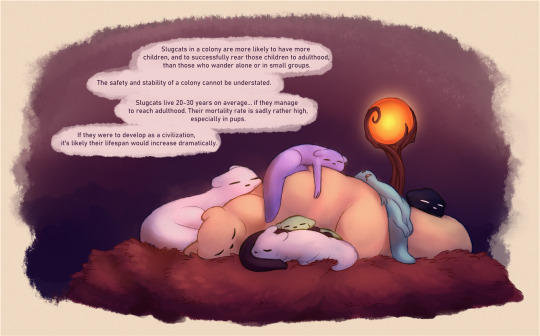
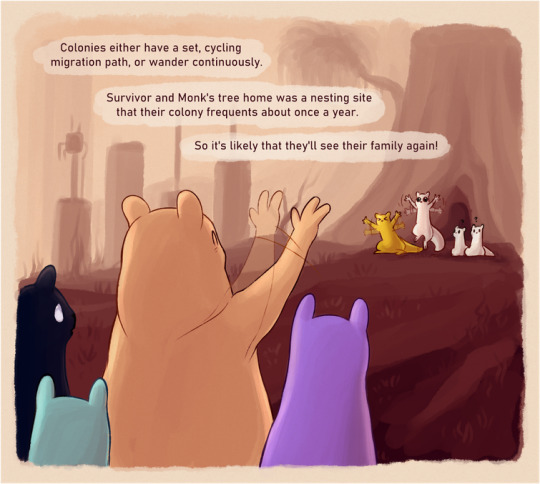


Playing with some ideas mostly regarding gender/reproduction in RW, and slugcat colonies.
Full transcript under the cut!
Creatures in Rain World are typically simultaneous hermaphrodites but require partners to reproduce, with either individual capable of being a genetic donor or carrier. Alongside what we are familiar with, this has lead to interesting reproductive strategies such as rotating donor/carrier roles, or dual/simultaneous genetic swaps.
Rotating donor/carrier roles - A K-selection reproductive strategy. One partner carries the first child, the other partner carries the next child, and so forth. Allows each partner to recover from the demands of childbearing.
Rain Deer aren't quite monogamous, but they tend to choose the same breeding partner whenever mating season rolls around. They serve as a donor one season, then bear and raise a child the next. Calves are raised away from the rain and worm grass, in places that have less food but more safety. Calf wool is softer, not yet gunked up by the dirty rainfall. Their legs are sturdier as children, allowing them to run for cover while the parent wards off threats.
Dual/simultaneous genetic swap - An r-selection reproductive strategy. Parents fulfill the donor and carrier role for each other. The more children you make, the more likely some are to survive!
Multiple batflies lay thousands of eggs in a single "blue fruit." Several eggs congeal and become nutrient paste for the surviving eggs (and for hungry slugcats). Like some plant seeds, batfly eggs that are consumed before pupating can survive passing through the digestive system. Ew.
Ancients also fell under this umbrella. Their genders (and the genders of iterators by extension, who have no sex anyways) could have been determined by a variety of other factors, such as societal role, donor/carrier preference, or simply different categorizations of personal expression.
It's difficult to say how well their common pronouns would translate to ours, but it seems they can translate to an extent, given what Moon and Pebbles use canonically.
Slugcats, like real slugs, can have children with a partner or self-fertilize. Unlike real slugs, they are often known to adopt.
In the case of self-fertilization: children who are born from one parent may display a large amount of genetic diversity despite the circumstances. Maybe slugcats have some sort of... genetic reservoir independent of their own genetic code?
Slugcats live 20-30 years on average... if they manage to reach adulthood. Their mortality rate is sadly rather high, especially in pups. If they were to develop as a civilization, it's likely their lifespan would increase dramatically.
Slugcats in a colony are more likely to have more children, and to successfully rear those children to adulthood, than those who wander alone or in small groups. The safety and stability of a colony cannot be understated.
Colonies either have a set, cycling migration path, or wander continuously. Survivor and Monk's tree home was a nesting site that their colony frequents about once a year. So it's likely that they'll see their family again!
...also, the strength of large colonies are why scavengers are likely to become the dominant species. In the time of Saint's era, continuous migration has become more of a risk, and it has become more difficult to support large populations. Slugcat populations have shrunk back to the more forgiving equatorial zones.
Saint's tongue is pretty unusual and probably unique to them, or to a small population that they hail from. Fur (of varying thickness) is much more common.
Meanwhile, scavengers are bulkier and covered in thicker insulating fur. They:
have seemingly massive populations
have a burgeoning society (the existence of merchants, tolls, bartering, elites and leaders)
are adept at communicating (non-verbally)
manipulate their environment
can build structures (scavenger-made structures were a scrapped idea from Saint's campaign)
can create complex weapons and tools
may have agriculture behind the scenes (unsure if scout parties prioritize exploration or hunting)
I would wager on scavengers developing more quickly than slugcats, but it would be nice if there was a future where both could co-exist.
#oops! impromptu rendering practice!#rotating donor/carrier roles could also be an r-selection strat#but i feel like it'd be more common as a k-selection strat#rain world#worldbuilding#headcanons#flickerdoodles#art#um#ask to tag?#that goes for all of my posts#rw spoilers#dp spoilers#saint spoilers#long post
2K notes
·
View notes
Note
Your centaurs differ pretty wildly from the base DnD centaurs, but what I am curious about is old people. DnD centaurs travel in migrations that last generations and just leave the old or infirm behind to keep on (at which point they become Chiron types); how do your centaurs handle the elderly?
I actually had no idea that DnD centaurs did that, kinda cool, kinda wild cultural practice?? While I have always encouraged folks to use my workarounds and patches for centaurs in their TTRPG games, I actually have very little idea of what ideas are already in any of the systems that do actually include centaurs! my advice on centaurs is usually much more niche daily life stuff than most game developers and story writers tend to delve into.
For my centaurs the elderly are treated much like any human elder, what do you do with them? You cherish them!! Particularly with my centaurs, who across all their cultures depend a lot on family and group dynamics to compensate for the challenges that come with having a horse body. So elders would be an important font of knowledge and cultural memory! Now MY centaurs in particular tend to be pre-history to medieval style cultures, with access to higher medicines pretty much limited to the Port city of the Merchant's culture so living to a super advanced age would be fairly rare, but that would just make those who DO get to that age generally more important and respected (at least according to Nana)
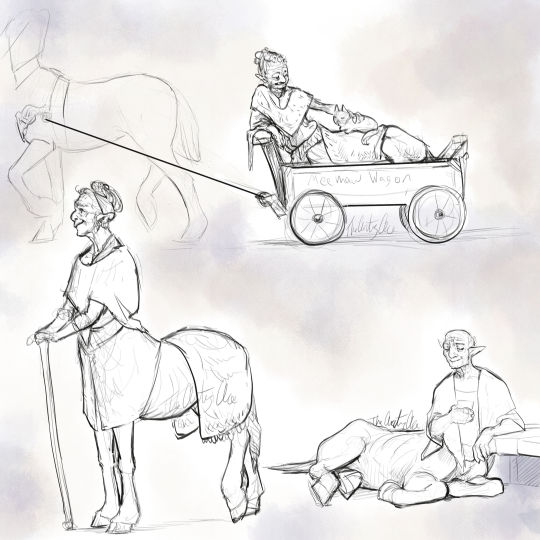
As mobility issues arise with advanced age, there's lots of options to keep Nana mobile and healthy, from supportive corsets and harnesses to support the back to senior comfort hoof trims and special shoes- but most end up opting for being (literally) carted around in small wagons by the grandkids. Or the more independent minded seniors may drive their own carts with pet ponies and donkeys (or even goats!)
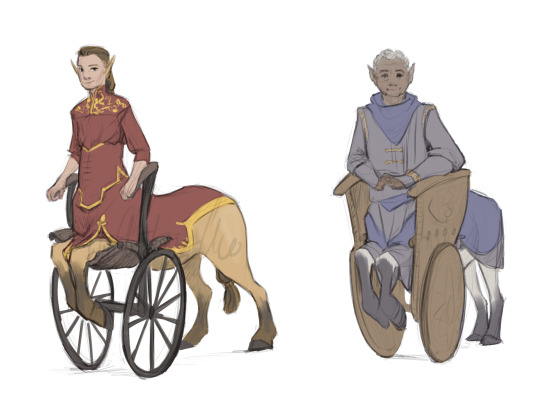
Of course wheelchairs are also an excellent choice to help with mobility at any age!
And even in my semi-nomadic Rider culture, elders are simply packed up with the yurts and tents and travel in the carts that way. No reason to leave them behind when you have stuff to be carrying anyway in my opinion!
#centaurs#asked and answered#worldbuilding#elder care#in which as usual I yap too much#new doodles!#because i couldn't resist the temptation#to draw some gummy lil old centaurs#cherish your elders people!!#i think the reason i get so into worldbuilding for centaurs#is because so many other systems#just treat them as smart monsters#or just Chiron#but a herd of him#more fun to me to explore a person#with the power and size of a horse#and how they navigate that
669 notes
·
View notes
Text

i almost want to do an expression sheet for him so i force myself to expand past his rbf. but its so easy and fun to draw him with one
#essek thelyss#the mighty nein#critical role#critical role fanart#mighty nein#m9#cr fanart#i like the setup of these low stakes sketches same as the fearne one lol#i just get to do a chill sketch adn then color + blend mode until im bored yippie!!#gave him a lot of layers on his outfit bc of one of my favorite shadowgast fics i read recently that will affect how i draw essek forever#in the closet of our discretion by firefright on ao3#REALLY cool worldbuilding through kryn fashion customs#im really excited to draw him in more outfits :]#itseart
1K notes
·
View notes
Text
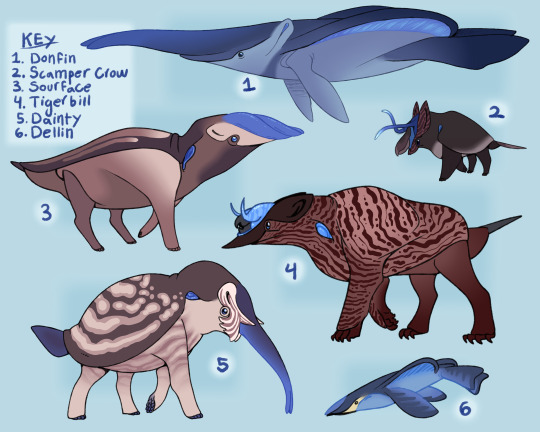
New critters from Styraland! Wanted to branch out into some other beasts hanging out. Infodump on 'em below!
All of these are members of the same family characterized by having a beaked mouth placed between two tentacles. Same as the styraphants! They are pretty varied but I want to have more types of animals so tryna reign them in a little to leave room for others.
1. Donfin- A marine carnivore who occupies a similar niche to a dolphin, using tentacles lined with sharp spines to ensnare small swimming prey.
2. Scamper Crow- A tiny nocturnal hunter who uses their skinny lil tentacles to lure in bugs to crunch up in their oversized beak.
3. Sourface- Possessing a spiraled mouth, these guys like to stick their face into foliage and strip the vegetation bare. Quite fast at it!
4. Tigerbill- An ambush hunter, which I named cause stripes, their tentacles are greatly reduced to avoid them getting in the way of their sharp beak. Though they mainly like to stab with their chin.
5. Dainty- Their tentacles are fused and used to cutely pick seeds out of the leaf litter, the horns on their face are for jabbing each other.
6. Dellin- Another fully marine fella, they travel in large groups mostly along the surface. They can launch themselves out of the water if startled. They are easily startled.
That's the basic info for all of 'em! This is also a lil chart for how they all factor into relatedness in reference to styraphants and each other.

Aside from that I got the BUG POST in the works. Which I am very hype for.
#styraphant#art#worldbuilding#speculative biology#spec bio#xenobiology#aliens#sorry for being sparse been drawin mostly for hire these days#want to do more ALIENS tho
925 notes
·
View notes
Text
Dungeon Meshi World Map
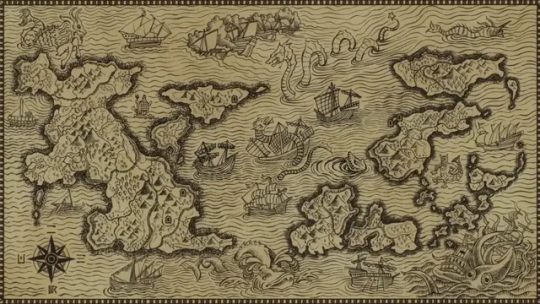
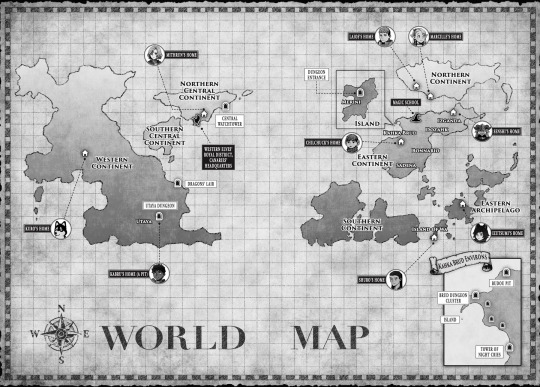
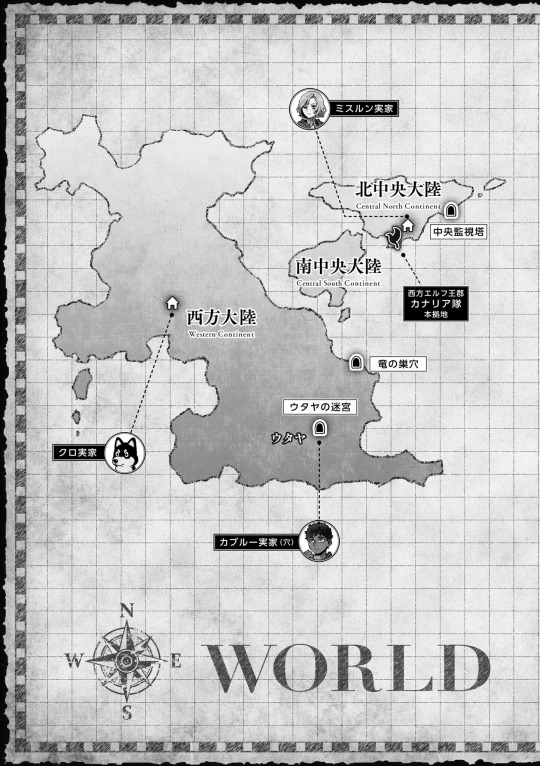
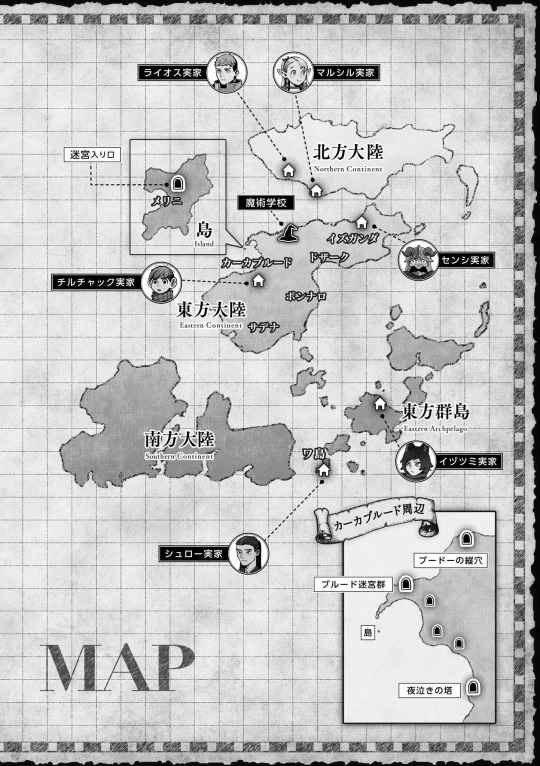
REGIONS (Descriptions taken from the Adventurer's Bible)
WESTERN CONTINENT
Description: Bears the most scars from the ancient war. It has many monsters and ruined dungeons, and although it's vast, there are surprisingly few habitable areas. Most of the inhabitants are sturdy, short-lived races and demihumans. Elven culture has had a strong influence here.
Characters: Kabru and Kuro
Places of Note: Utaya
Dungeons of Note: The Utaya Dungeon, The Dragon's Lair
NORTHERN CENTRAL CONTINENT
Description: The continent that is home to the largest nation, ruled by the queen of the elves. The term "Western Elves" mostly indicates elves from this region. It's the safest area and life is easy here, but its shrinking population has dangerously weakened it.
Characters: Mithrun (and the Canaries)
Places of Note: Western Elves's Royal District, Canarie's Headquarters.
Dungeons of Note: Central Watchtower
SOUTHERN CENTRAL CONTINENT
Description: The area with the second-largest elf nation. It has more inbound immigration than the Northern Central Continent and a rather disorganized atmosphere. While it's in an alliance with the Northern Central Continent, they really aren't on good terms.
Characters: -
Places of Note: -
Dungeons of Note: -
EASTERN CONTINENT
Description: Home to the largest gnome nation. Once dwarfs and
gnomes made up the majority of the inhabitants, but in recent years there has been an influx of short-lived races from the Northern Continent and Eastern Archipelago, and the population is growing rapidly. It's a melting pot where various cultures are jumbled together.
Characters: Chilchuck Tims (Kahka Brud), Senshi (Izganda)
Places of Note: Magic School, The Island/Melini, Kahka Brud, Izganda, Dozahk, Bonnario, Sadena
Dungeons of Note: Island, Brud Dungeon Cluster, Budou Pit, Tower of Night Cries
NORTHERN CONTINENT
Description: A severely cold continent where over half of the land is covered in perpetual snow. The majority of the inhabitants are short-lived races, particularly tall-men, but the population isn't large to begin with. It has been strongly influenced by dwarf culture.
Characters: Laios & Falin, Marcille
Places of Note: -
Dungeons of Note: -
EASTERN ARCHIPELAGO
Description: An area where short-lived races live. As a result of a pact, there has been no interference by long-lived races for a very long time. The effects of the ancient war are slight, and they have almost no trouble with monsters or dungeons, but there's constant strife among humans.
Characters: (all from different Islands) Izutsumi, Shuro and his Retainers, Rinsha Fana (Not shown)
Places of Note: Island of Wa
Dungeons of Note: -
SOUTHERN CONTINENT
Description: Home to the largest dwarf city. Gnome and dwarf nations often build down rather than out, and the innermost layers are extraordinarily deep. War still erupts frequently, and there are never-ending disputes near the borders.
Characters: -
Places of Note: -
Dungeons of Note: -
If you're interested I've found a post on pixiv with the map outlines and some more info (in japanese)
I'll make a post about the dungeon descriptions later but here they are, there's a little more info about Kahka Brud dungeons on my last map post
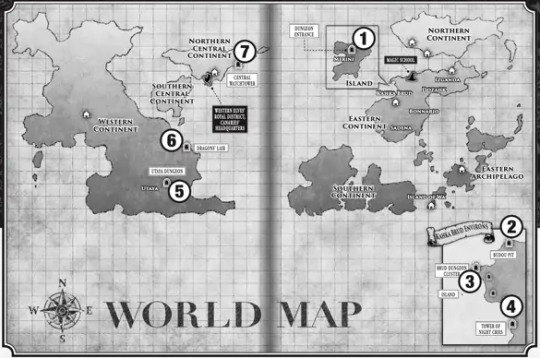
1 The Island, 2 Budou Pit, 3 The Brud Dungeon Cluster, 4 The tower of Night Cries 5 The Utaya Dungeon 6 The Dragon's Lair 7 The Central Watchtower
Map Outline
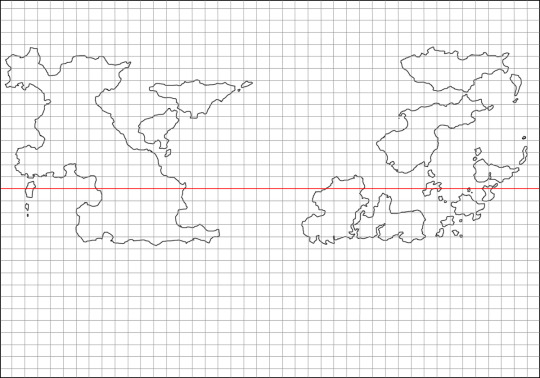
#dungeon meshi#dungeon meshi map#adventurers bible#maps#world map#Laios Touden#Marcille Donato#Senshi of Izganda#Chilchuck tims#Izutsumi#Toshiro Nakamoto#Kuro#Kabru of utaya#Utaya#The canaries#Mithrun#Edit: Shame on me I forgot to add one more map and a link to a pixiv post with the outlines#longpost#long post#worldbuilding#world building#fantasy map#fantasy world#for referencing
1K notes
·
View notes
Text

The Kadez is a medium-sized river chelicerate, living in particularly pure, well-oxygenated streams. It tolerates very cold temperatures and as such is often found in mountain streams. They turn over pebbles with their legs in search of small invertebrates, roe, and other small prey to eat. It is quite an active creature, and in areas where they are abundant, they'll often come up onto land for other food sources. That said, they are quite skittish, and surprisingly fast -especially underwater-, so it isn't always easy to approach them.
#okali#fantasy#wandering okali#art#graphi's things#worldbuilding#species#speculative biology#specbio#xenobiology#xenofiction#fantasy biology#fantasy creature#fantasy art#fantasy worldbuilding#creature design#my first chelicerate! yes it is basically a horseshoe crab but listen. they are lovely and deserve at least one spot in okali#besides i like having designs very close to earth counterparts first before branching out into more fantasy stuff
680 notes
·
View notes
Text
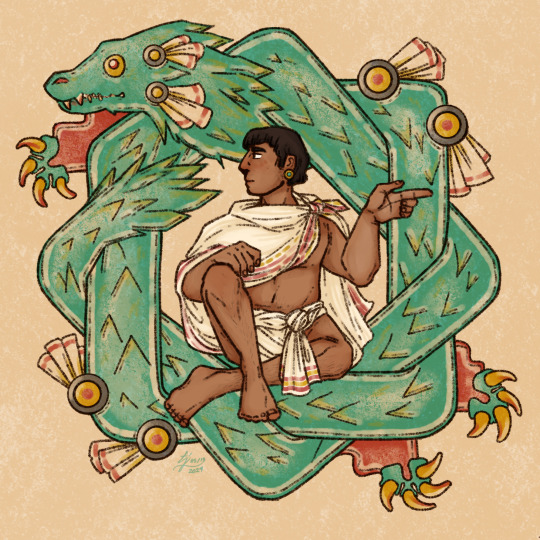
c. 1540 CE: a young man from Chalco, and his dragon.
#em draws stuff#em is posting about temeraire#temeraire#temeraire worldbuilding collection#<- tag for organizing when I'm drawing stuff that is temeraireVerse but not in the line of the plot of the books themselves#for school reasons I have been reading a lot about 14th-17th century mesoamerica#and thus am Interested in how that would have potentially played out in temeraireverse...#anyway! not sure if I'll draw these two again but I Have given the lad a day sign name (five deer) so I could Potentially. who can say.#haven't come up with a name for the dragon yet... maybe cipachcoatzin would work if can't think of anything else#<- Please Forgive My Dubious Command of Classical Nahuatl Grammar I Am But A Student#on that note zoomorphic interlace is not very much a style from this period/region but it helps me with composition things#five deer himself is mostly based on the illustration of the tlacuilo's son in the codex mendoza#the dragon is drawn more from a fusion of older scribal styles (ie. the codex borgia) and my own shorthands for dragon anatomy
527 notes
·
View notes
Note
I just have a quick question. Is Titania a part of your little fairy ask thing? I only ask because she and Oberon are seen as the rulers of all Fay creatures. This is mostly due to a funny thought of Jorgen telling someone that he doesn't actually make Da Rules, just inforce them.


After the Great Fairy Wars, Titania and Oberon receded from public view. Nobody's seen them since the wars ended. In fact, the current Fairy Generations have never so much as heard their names outside of history books. They're more like myths than real fairies.
Timmy likes visiting their statues at the Fairies' Supreme Courthouse, though. They have an air of calm and somberness to them. It's a nice place for a respite whenever he feels overwhelmed.
Bitties Series: [Start] > [Previous] > [Next]
#fairly oddparents#fop#fop a new wish#fop timmy#fop timmy turner#timmy turner#asks#itty bitties fop au#ficks of fancy2#the only ones who may have seen them are the leisure court fairies who survived the wars like jorgen and tooth fairy#but none of them brings this up or bothers correcting new fairies who thinks they're just myths or legends#they dont. really talk about the wars. or about the past.#but also bcs the wars aren't the main focus of the story so these two are more like worldbuilding tibbits!!! very fun!!#they exist!!! but they're not important to the overall story#ALSO YIPPIE I GOT TO REUSE THE TIMMY DRAWING !!!
327 notes
·
View notes
Text
I'm not a linguist and I find the whole excercise of conlanging, while I love it and respect it, beyond my abilities, but I do have one thing or two to say about linguistic diversity and how boring is to have a "common" or "basic" language in fantasy or science fiction without exploring the implications.
Being a bilingual speaker of Spanish and English, and someone that because of work reasons and entertaiment tastes interacts a lot with English, I tend to see English as the equivalent of those "common" or "basic" languages of speculative fantasy. As a useful tool for communication, science technology and commerce. In real life, however, as you are aware, the expansion of English tends to undermine local languages, it's considered more valuable to know English that to know the language of your grandparents, or learn any other language you just feel curious about.
The experiences of every multilingual person are different, but in mine I know English, I write and read and listen to English a lot. But I don't consider myself an English *speaker*, I speak Spanish and more to the point Argentine Spanish, that's the culture I identify with, and it's the language I use to express my feelings and inner thoughts. I can't imagine saying "I love you" to anyone in English, to me it's just a tool I use to access to knowledge or communicate through language barriers ("basic", "common"). But interestingly, by both writing and participating in the wider English-speaker internet culture, isn't it part of my own culture, as an individual, too?
The fact is that English also has a culture(s) and a history and a corpus of literature. So when we write about "Common" or "Basic" languages in fiction we need to ask ourselves: where did they come from? How did they become the standard? Is there a literature, a canon, a culture of "Common" in your fantasy world? What about other languages, other cultures that aren't raised learning it and see it just as a tool? Because no matter the strenght of Anglophone cultural imperialism and the social value of learning English, I don't see Argentines, or for that matter Chinese, Italians or Russians abandoning their first language. And yet even in English and in all other languages (ESPECIALLY other languages, English is remarkably uniform) there is a variety of dialects. And we need to remember, once Latin was spoken only in a village in central Italy, and English in a rather remote rainy island. They weren't destined to have their future roles, history drives language.
So, when an author goes for the "universal language" explanation to avoid linguistic misunderstandings, for me, it raises more questions that I believe are worth exploring.
#cosas mias#anyways I will write more WHEN I get my computer I can't type unhinged rants like this#worldbuilding#linguistics#language
350 notes
·
View notes